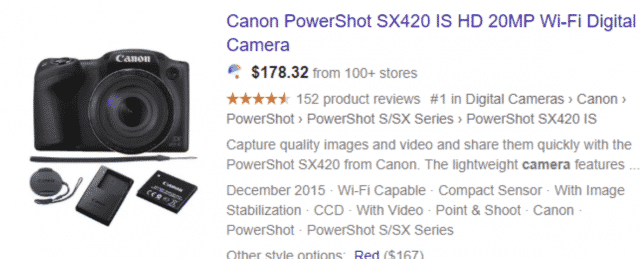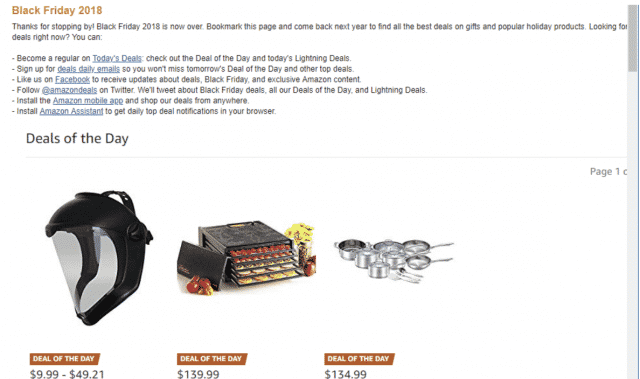Optimizing your ecommerce store and its product pages for search is a challenging balancing act. First, you have the side focused on strategically crafting content on the page so that it ranks well on serps and drives traffic (read: customers).
This is a lot easier said than done, especially if your products are connected to high-competition keywords.
But, ranking well and driving that valuable search traffic is just one priority. If your product pages aren’t descriptive, full of creative assets and subtly persuasive, those shoppers won’t be enticed to click the “Buy” button.
In this discussion, we’ll look at how even a small business’ ecommerce store can achieve this blend of well-ranking, search optimized product pages that convert traffic to dollars.
If You Build Well-Written Product Pages, The SEO Will Come
The most important tip or lesson I can impart on you, the reader, about product page SEO is to focus on writing unique, useful and readable product descriptions above all else. Yes, incorporating keywords is important. Yes, linking out to other parts of your website is smart.
But, these SEO efforts shouldn’t get in the way of producing content that allows customers to learn about your products and answer any shopping questions that they have.
When you write quality descriptions, good SEO follows. For example, customers won’t have to go elsewhere to answer those shopping questions and they’ll be willing to stay longer on your product pages. This will help improve your bounce rates and dwell times. To search engines like Google, this will signal the authority of your product URLs and thereby raise the rankings for these pages.
In this respect, SEO and the user experience are somewhat interrelated when it comes to optimizing your product pages for search. However, if there’s ever a choice between enhancing one or the other, always lean towards the customer experience side.
Avoid Too-Good-To-Be-True Shortcuts When Writing Descriptions
Unfortunately, a lot of ecommerce websites don’t abide by my golden rule of focusing on writing quality and unique descriptions. They fall into two common pitfalls of product page descriptions: 1.) adapting the same description for multiple products, or, 2.) using a product description generator (yeah, they exist).
I can’t exactly fault every web owners for these kinds of strategies. Creating unique product descriptions for each item on your ecommerce store is incredibly time-consuming. And, if you don’t have the time to write them yourself, it can be a serious investment to bring someone in that can.
In fact, these tactics can be great in the short-term. Most of your customers, about 79%, want to scan some sort of short product description to research your products before buying. You can quickly populate all of your product pages in a short amount of time. After all, having some content is better than none.
They are ideal for a new website that needs to fill those product pages ASAP. That said, ecommerce store owners need to have a clear timetable of when they’ll replace these generated or copy-pasted descriptions with unique, well-written ones.
Pay Close Attention To Meta Titles And Descriptions
When consumers see your products in search engine results, the first information or content they’ll see is the meta title and description. Thus, these are incredibly important aspects in your product page SEO. You have a very limited amount of character space to title and describe the product in question, which means not a lot of space to entice a potential shopper to click and ultimately buy.
Again, it’s a tightrope walk between tactfully placing SEO keywords and making the descriptions and titles readable. The difference is there is a lot less room for error.
Meta Titles
It’s best to keep meta titles below 55 characters, as anything over that will get truncated by most mobile screens. I like to follow a meta title formula that looks something like this:
Primary Keyword – Brief Description Modifier – Brand Name – Bonus Benefit
Your primary keyword should always come first. Then, you can add a modifier to add more detail about the product. You can look at long-tail keywords that use your primary term for inspiration. Finally, the brand name, if it hasn’t already been included in the primary keyword.
Still got some character space left? You can add an additional benefit as a final effort to trigger a click, such as “free shipping,” “fast delivery,” “save X%,” etc.
Examples:
- Red Ball Gown with Open Back by Macy’s – Free Shipping
- Sony LED 4K TV for under $200 with Free Home Install!
- Wingback Chair with Ornate Legs | Ross & Main Save 20%
Meta Descriptions
With meta descriptions, there’s a bit more room to play around with. Your average meta description will run up to 300 characters. If you have to go over, it is okay, but the end of your description may be cut off, which means customers will miss valuable text. So, be sure to include the most relevant information and keywords first.
As with your full product descriptions, you want to do your best to make each meta description unique as well. This can be a really challenge, especially if you’re describing the same product but in different colors, sizes, styles etc. But, do your best to make the descriptions distinct from one another.
It’s also a good idea to include some sort of call to action in your descriptions (and, sometimes in the title, if space merits).
Rich Snippets And Google Shopping Schema
Meta titles and descriptions have had their importance slightly spoiled by the introduction of Google’s rich snippets and shopping marketplace. Now, Google users don’t always see your meta title/description content, because they find your products in the shopping pane or through another rich snippet.
However, you need the right markup on your pages to alert Google that your product pages are, well, product pages, and that they contain additional data like reviews, product specs, ratings, etc.
The structured data that the search engine uses to form a rich product snippet can be found at Schema.org. There’s a variety of different product-related schemas to explore and implement. Utilizing structured data means using data formats like JSON-LD, RDFa and others. JSON-LD is a little more popular with Google.
It’s worth mentioning that, even after you’ve included this structured data and given Google all the clues it needs to add snippet assets to your products, there’s no guarantee that your schema data will actually show up in results. This is still at Google’s discretion, just like your ranking position.
Encourage Customers To Leave Reviews
One of the more powerful components of your Schema.org markup is the chance to showcase the review data of your products. Reviews are very powerful motivators for conversion. The simple truth is that your customers trust the accounts of other consumers a lot more than anything in your description or marketing materials.
In fact, 9 out of 10 shoppers find customer reviews more trustworthy than a salesperson.
And, so does Google and other search engines.
Their ranking algorithms are designed to give a user the most relevant websites and content based on his or her query. When products feature reviews, they add more value and information for the searcher, which Google rewards with better rankings.
Plus, product pages that post reviews are updated more often. Google looks at pages with frequent updates more favorably because this is an indication that the content is fresh and up-to-date.
Bazaarvoice, a firm focused on making better use out of customer ratings and reviews data, created a massive study that looked at more than 57 million reviews and 35 billion unique visits to product pages. The findings yielded a promising connection between available customer reviews and higher sales. With just one review, a page receives 10% more orders. That figure jumps to 37% when reviews pass the 100 mark.
Build And Maintain Authority By Preserving Unused Pages
Next to reusing product descriptions across multiple pages, the next biggest mistake I see ecommerce site owners making is deleting/deactivating inactive product pages. There’s any number of reasons why a product page may become inactive. The most common is seasonal products.
While these items may not see (nor need) high volumes of activity all year round, removing those pages entirely can have damaging effects on SEO when you do expect them to have activity. Consider, for example, Amazon keeps a Black Friday page up year long.
This tactic allows this Amazon page to maintain its page authority, even when the Black Friday holiday is long over. Page authority is built over time. Thus, when you remove the pages that you feel are no longer providing any value, you’re actually sacrificing the time and effort you spent in building this important metric. And, when those pages are relevant again, you’ll have to start all over again.
If you have inactive pages for out-of-stock or seasonal items, don’t discard them entirely. You can have them redirect to relevant product pages or go the Amazon route.
Keep Your Online Store Organized
This is a beautiful tactic because it serves both the customer experience and the SEO of your product pages. Utilizing product categories, subcategories and other site structure components will make it easy for your customers to find the precise products they’re looking for. And, it will help declutter your sitemap, which makes your website easier to crawl.
When your site is designed with this heightened level of organization, linking from page to page becomes much easier. Your customers with move logically from page to page, product to product. So, it will be easier for them to find more relevant items to purchase.
You’ll not only have a higher chance of converting and making the all-important sale, but your customers may be encouraged to spend more because they’ve found more products on your ecommerce site that relate to their needs/wants.
Test!!!
If you’ve read my other discussions, then you already know that I am a true fanatic about testing and monitoring any new strategies or changes you’ve implemented on your sites and pages. I’m sorry if I sound like a broken record on this front. However, testing is doubly important when it comes to product pages.
This is one of the final stages in the sales funnel, which means there’s a lot more on the line. A small change here and there, even a subtle one, can be the difference between making a sale and not.
Successful ecommerce site owners are always testing and adjusting strategies, whether it’s a new keyword in the meta title, a different structure to product descriptions, more schema markup or another tactic. You never know what adjustment will make the difference your site needs.
It’s important to only test one change per product page. If you make more than one adjustment on the same page, it will be difficult to determine which one is causing the change.
Conclusions
Still want more SEO tips for product pages on your ecommerce site?
If you’ve completed all of the tips in this discussion, then my next piece of advice is to look at the current and upcoming trends that are, and will be, affecting product page SEO. For example, you may want to begin thinking about how your ecommerce pages appear on mobile devices or how optimized they are for voice search.



